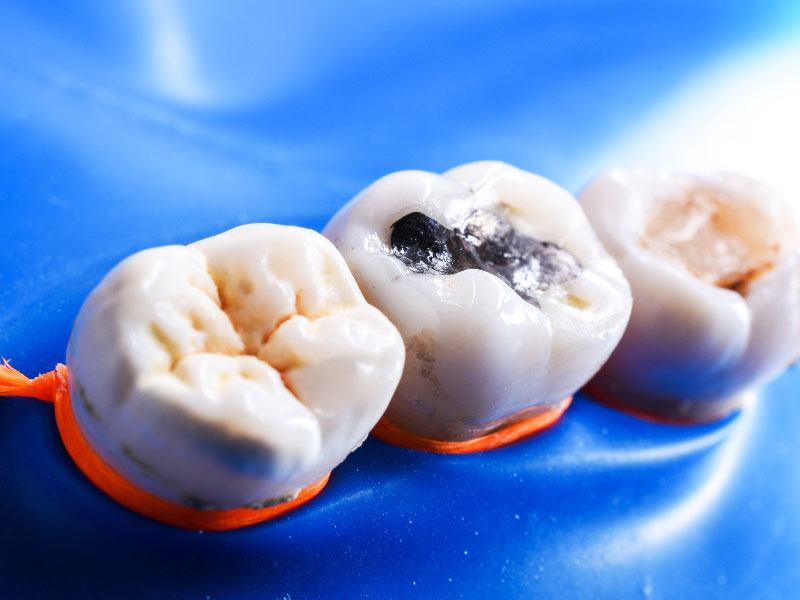The Differences Between Composite and Metal Fillings

We want you to feel confident about your smile. Sometimes, a little bit of work needs to be done so you can have the best smile possible. If you have a cavity and need a filling, you typically have two options.
First, there are the traditional metal fillings. These are the kinds of fillings you’ve likely gotten as a child where they put a metal star in the cavity of the tooth. However, with more recent technology, composite fillings have been created to offer a more natural look. Let’s take a look at the difference between composite fillings and metal fillings. From there, we can see which is best for your smile.
What is a Metal Filling?
Metal fillings are also called amalgam fillings where dentists will take a metal mixture of liquid mercury, silver, tin, and copper all mixed together and use that to fill in a cavity. The mercury will bind together the silver, tin, and copper to create a strong bond that will stick to your tooth and prevent further decay. These fillings take on a silver appearance which has earned them the somewhat inaccurate nickname of silver fillings.
This form of cavity filling has been used for a very long time and only in recent years have dentists been looking into different cavity solutions. Metal fillings have certain risks to them as they are created with small amounts of mercury.
The Benefits of Metal Fillings
Metal fillings have a few benefits that have allowed them to be used for filling cavities for a long time. First, they are strong and long-lasting. It is unlikely that these fillings will break within the tooth where the tooth will begin to decay again. Metal fillings are also very inexpensive which helps people who don’t have amazing dental insurance still be able to protect their teeth.
Some patients have a higher risk of tooth decay and need a material that is resistant to moisture and super durable. Metal fillings are a great solution for this problem and allow patients to protect their teeth even with their risk of tooth decay.
The Risks of Metal Fillings
Metal fillings may have been around for decades and are a classic option for filling a cavity, but they still have their selection of risks. As mentioned earlier, metal fillings contain mercury. This liquid element is extremely dangerous in an uncontrolled setting. By breathing in the vapors from mercury or ingesting small amounts of it, there can be harmful side effects on the body such as damage to the lungs or damage to select organs.
Children who get metal fillings are at higher risk of damage that can happen from mercury. This can lead to neurological consequences, more so with younger children. Finally, some people may simply be allergic to the compounds that go into the metal fillings. Some people are sensitive to even small traces of mercury and allergic reactions to any of the metal components vary from person to person.
Of course, this isn’t to say that metal fillings are dangerous and shouldn’t be used. Dentists and scientists have worked hard to find the right combination of metals that are safe to use in the mouth while causing the least amount of side effects possible. Yet, there are always outliers that have had reactions to the components of metal fillings. With composite fillings, many of the risks from metal fillings are decreased or eradicated.
What are Composite Fillings?
Instead of this filling being made of metal, composite fillings are made from “plastic and glass to closely resemble your tooth's natural luminosity” (drogata). Other materials can be used to create a composite filling. Instead of having a silver “star” on your tooth after getting a cavity filled, composite fillings match how your tooth looks to create a seamless look. You will wonder if you even had a cavity at all.
The Benefits of Composite Fillings
Composite fillings are more recently developed to decrease the risks that are associated with metal fillings. The first benefit is that composite fillings look a lot more natural that metal fillings. They will resemble how your tooth looks instead of being a startling different color. Composite fillings are also a part of cosmetic dentistry where these fillings can change the look of your tooth. They can cover discolorations, fill in chips and cracks, and can even change the shape of your tooth.
Also, composite fillings don’t require as much drilling. With metal fillings, dentists have to remove a large portion of the tooth so that the filling can properly bond. Composite fillings don’t require this and have an easier time bonding to your tooth.
The Risks of Composite Fillings
In some of the materials that are used in composite fillings, BPA can be found in very small amounts. This has made some people worry about the effects of BPA in fillings as BPA can cause health problems with long-term exposure. These BPAs are found in the resin that is used to create composite fillings in the shape of the whole in your tooth. There needs to be more investigation to determine if these levels of BPA in fillings will lead to harmful side effects in people.
Get the Filling Best for You
You get to determine which benefits and risks you want to choose for the health of your mouth. Overall, the risks of composite fillings are less (however they are less researched) than the risks of metal fillings. Metal fillings have been the traditional choice for many decades, but more and more dentists are looking into the benefits of composite fillings.
Our dentist can provide you with composite fillings in Kahului. Our Kahului dentist, Dr. Lance Ogata, can help you achieve the best smile possible. Here, composite fillings are available for those with cavities or who have another need for cosmetic dentistry.
Get the smile you want by finding the right dentist for your needs. Contact us today!
